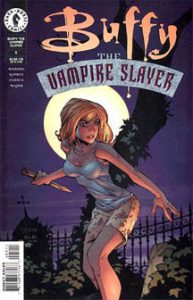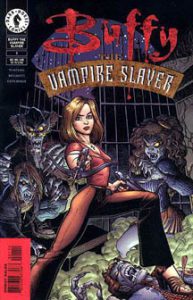Today, comics are the home for the further adventures of Buffy, but the Slayer and her friends got off to an inauspicious start in the medium with writer Andi Watson’s Issues 1-11 (September 1998-July 1999) of the original series, now often called “Buffy the Vampire Slayer Classic.” Whereas the novels expand the mythology as much as possible within the constraints of TV show continuity, the early comics contract the scope.
The comic starts in the Archie mold, with each character filling a steady role; some are closer to their TV personalities than others. Buffy bickers with Giles about her duties. Giles looks things up on a shallow level, like researching “ghouls” rather than a specific cadre of ghouls. Willow is computer- and spell-girl. Xander is tougher and braver than we’re used to, starting with his martial arts lessons in “Wu-Tang Fang” (1). Cordelia complains about being a Slayerette, yet is reliable. Angel conveniently lurks around. The most off-point character is Oz, who delivers sharp barbs like Xander, rather than being the laid-back nice guy. Amy randomly pops up in “Bad Blood, Part 3” (11) to cast a spell on a guy who snubs her, but the comic generally doesn’t venture beyond the core seven; for example, Faith is not even mentioned.
As with the books, three continuity points help us place these 11 issues on the timeline: 1) Oz is a werewolf, 2) Everyone knows Angel is back, and 3) Xander and Cordelia are a couple. This means the stories can only take place between “Revelations” (3.7) and “Lovers Walk” (3.8). That works for a while, but Dark Horse also wanted the stories to reflect the calendar. So while “Halloween” (2), “Cold Turkey” (3) and “White Christmas” (4) could plausibly fit in that timeframe – if you use a surgical spreader between the two episodes – it’s impossible for “Happy New Year” (5) to fit, since New Year 1999 happens after the Christmas episode “Amends” (3.10).
Watson’s plots find a standard bad guy(s) in Sunnydale that Buffy and friends dispatch by the final panel. The villains never have any personal or metaphorical connection to the Scooby Gang. These early “Buffy” issues take a traditional superhero comic approach where time goes by but the characters work through the same short list of problems and worries without really growing. This is understandable since the gang was doing some serious growing up on the TV show, and the comics couldn’t compete with that no matter what they did.
One idea presages a TV plot. In “White Christmas” (4), Buffy works at a mall popsicle stand to pay off Slaying-related damages to a car, a sneak-peek at Season 6, when she lands a job at Doublemeat Palace. Buffy’s job as a model in Issue 9 (“Bad Blood, Part 1”) is a more comic-y concept, but worth it for Cordy’s reaction to the agent’s interest in her less-fashionable frenemy. Some arcs rely on out-of-character motivations: Willow gives the silent treatment to Buffy for hurting a wolfed-out Oz (5, “Happy New Year”), and Joyce considers plastic surgery (9, “Bad Blood, Part 1”).

The most fun plot, at first glance, is in “New Kid on the Block, Parts 1 and 2“ (6-7), co-written by Dan Brereton. But the mystery of new girl Cynthia fizzles — she’s just a demon lining up girls at a slumber party for a vampire buffet. “The Final Cut” (8) is fun for the way everyone gets involved with a low-budget movie, although it also suggests that single-issue yarns are inevitably going to lack depth.
Trivia buffs might find it interesting to know the gang’s Halloween costumes in Issue 2, since Season 3 didn’t have a Halloween episode. Buffy goes as Jason from “Friday the 13th,” Xander is a classical vampire and Oz is a shark (Willow is kidnapped by vampires, and therefore misses out on dressing up).
These early comics do some blatant things to be different from their source material. It’s ironic that a couple years later, Joss Whedon would instruct the “Angel” title to embrace the comic-book medium rather than mimicking the TV show, because from the start, “Buffy” pencilers/inkers Joe Bennett/Rick Ketcham (1-3, 9-11) and Hector Gomez/Sandu Florea (4-7) revel in the fact that this is a comic. I like the teams’ art about equally, with Bennett/Ketcham bringing more kinetic energy and Gomez/Florea delivering richer panels, although Bennett perhaps deserves the bulk of the credit (and blame, if you’re critical) for establishing the title’s ongoing traits.

Although the Sarah Michelle Gellar likeness is decent, Buffy is leggy and sexy, particularly as drawn by Bennett. Xander is beefed up to the point where I sometimes can’t tell him apart from Angel (admittedly, Nicholas Brendon was buff, but the TV show downplayed that with his wardrobe). Cordelia looks the most like her TV counterpart. Oz and Giles are too muscular, but their wardrobes make them pop. The artists struggle a bit with Willow; I generally figure out she’s the girl who’s not Buffy or Cordy. Principal Snyder is so far off base that I have to assume the artists didn’t have the rights to Armin Shimmerman’s likeness.
Buffy’s stakings are creative, including the use of an apparently wooden high heel in Issue 1, and the green cloud of dust works well as a dusting “special effect.” The vampires – who have glowing red eyes — are gray-skinned if they are freshly turned, green if they are older, and reminiscent of “Batman’s” Man-Bat if they are ancient. Indeed, the vampire Selke gradually decomposes as she goes longer without fresh blood, leading to the plot of “Bad Blood” (9-11), where she recruits an unwilling scientist to make her look young again. However, age doesn’t equate to power here, like it does in the TV mythology, as with the facially blood-stained Master in Season 1 or the cloven-hooved Kakistos, the bane of Faith’s existence in “Faith, Hope and Trick” (3.3). Whatever these Bennett-verse vampires look like, Buffy stakes them with equal aplomb.
While Sunnydale sometimes being called “Sunnyvale” is a mistake, it’s clearly Bennett’s stylistic choice to give The Bronze a massive façade complete with gargoyles and to outfit the library with a floor-to-ceiling window. I found it jarring at first blush, but soon embraced the stylization. Indeed, there’s little to argue with about the art, but in these 11 issues, story is treated like little more than a necessary foundation for the visually pleasing panels.
Click here for an index of all of John’s “Buffy” and “Angel” reviews.

